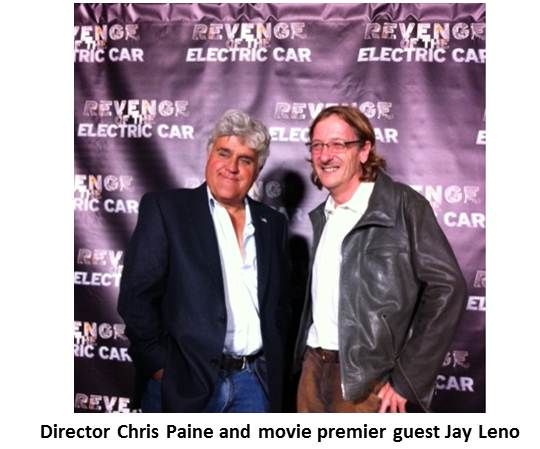The Revenge of the Electric Car, a new documentary film from director Chris Paine, tells the story of what happened between the end of Who Killed the Electric Car?, Paine's surprise 2006 cult classic, and the emergence of today’s incipient plug-in vehicle marketplace revolution.
It begins with scenes of crushed EV1s from the early 2000s. “Somebody made a deal to kill the electric car,” actor and EV1 devotee Danny DeVito wistfully observes, “or I still would’ve been driving it now.”
Paine summarizes the consequences of the car companies’ failure to seize the opportunity in electric vehicles (EVs) with headlines heralding Detroit's financial woes. “Here’s where we are now,” Wall Street Journal automotive authority Dan Neil then adds. “There’s not only a business case for electric cars -- there’s a compelling business case. There is an inevitability to this technology.”

In a compelling opening act, Paine introduces four characters through whom he tells the story of the plug-in vehicle’s revival, survival and eminent success.
First is GM’s Bob Lutz -- the man who championed the plug-in hybrid electric Chevrolet Volt, a crusty, cigar-smoking, larger-than-life corporate executive who previously shepherded the Hummer for GM and doubts the veracity of climate change science. In an example of the film’s willingness to let the viewer get the joke, it shows Lutz saying of himself, “I do consider myself an environmentalist -- but within reason.”
Next is Elon Musk, founder of PayPal, space shuttle competitor Space X, and all-electric sports car company Tesla Motors. Musk is the truest of the film's true believers and repeatedly expresses his idealistic dream of defeating Big Oil with the plug. "Elon is a career troublemaker," the film’s narrator Tim Robbins reports. “He’s taken on the banks, the space industry, and now the car companies.”
Lutz’s doubt that a Silicon Valley entrepreneur can succeed in the car-making business is one of the fascinating conflicts Paine weaves through the narrative. “Whether Tesla is ever hugely successful or not,” Lutz says, “I’ll always owe him a debt of gratitude for having broken the ice.”
Paine’s first movie was about little guys standing up to giant corporations, and he reveals that his sympathy remains with them through this film’s third central character, a quirky character nicknamed Gadget who is one of the many garage entrepreneurs still converting cars with standard internal combustion engines to fully electric cars. In another of the subplots Paine weaves into the story, Gadget works to convert an antique Porsche for a 100-mile road trip while the film’s corporate empires race to bring plug-in cars to showrooms.
The last of the central characters is Carlos Ghosn, head of Nissan and the force behind the Nissan Leaf, the first mass market all-electric vehicle. “There is no give in that man, there is no dream in that man. He is not a visionary. He is a capitalist,” the WSJ’s Neil says. “Carlos Ghosn doesn’t get up in the morning unless there’s money in it.”
Ghosn makes the business case for EVs in unequivocal terms. "I'm very confident about what's coming. What I don't know is how fast," he says, adding, "We think it's going to be a huge return for the company. We're going to have to be patient and we're going to have to manage it." But, he says, electric transport will change Nissan, the car industry and the world. "What is at stake is huge."
With his characters introduced, Paine finishes laying out the race to the marketplace between them. His new movie tells its story very differently from its lower-budget, edgier predecessor. The EV may still be a cause to some but to those who control its fate, the plug-in car is now big business. To succeed, both the car and the film must appeal not to a cult but to big audiences.
The film’s one real problem arises out of its greatest strength. Often documentary films get a little tedious in the middle. Yet history gave Paine the gift of an unmatchable twist in the story line. Just as Lutz, Musk and Ghosn were getting ready to race for the finish line, economic havoc turned the marketplace upside down.
The EV’s revenge, which is the story’s expected climax, was supposed to come at the end of 2010. But the financial crisis set it back a year. That made the struggles of the film’s main characters much more interesting, turning them into what Hollywood would call a great second act.
Paine documents the travails his main characters endure as they struggle to keep cars with plugs viable. An aging Lutz scrambles to defend his legacy, an over-leveraged Musk holds on by his fingernails to his fortune and personal life, and Ghosn fends off corporate pressures.
Unfortunately, the economy's woes also delayed the EV’s revenge. If best served cold, the EV’s revenge is still chilling as the film ends, making the climax a little vague. While the viewer would like to see evidence of real triumph, Paine can only offer the EV’s arrival in the marketplace and predictions of its potential.
A documentary filmmaker, like a car maker, is harnessed to reality and to production and release schedules. Because of the car makers’ delays, the filmmaker had to structure his climax to reflect two important and almost certainly true but not evident things: that the EV’s survival into today’s marketplace is revenge enough for now and that the arc of history makes its eventual success inevitable.



